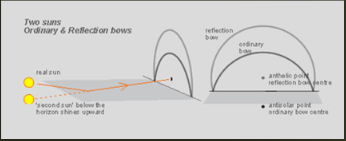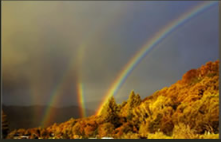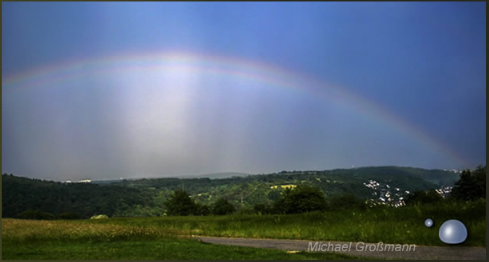Puzzling triple rainbow
Puzzling Triple Rainbow: A Fascinating Atmospheric Phenomenon Explored
Rainbows have long captivated our imagination with their vibrant colors and ethereal beauty. Most of us are familiar with the classic primary rainbow, which forms when sunlight is refracted and reflected within raindrops. However, sometimes nature surprises us with rare and perplexing phenomena, such as the puzzling triple rainbow. In this article, we delve into the intricacies of this captivating atmospheric optics phenomenon and explore the various theories behind its formation.
The image captured by Terry Wooten in Winston-Salem, North Carolina, showcases a truly extraordinary sight. Instead of the usual single primary rainbow, there are two equally wide and colored primary bows, accompanied by a secondary bow above them with its colors reversed. All three arcs appear concentric in the image, adding to the visual intrigue. Let's dive deeper into the possible explanations for this rare occurrence.
Unraveling the Mystery of the Triple Rainbow
Two Suns?
One possible explanation for the doubled primary rainbow is the presence of two suns. However, this theory quickly loses its plausibility upon closer examination. The spacing between the two "suns" in the image is approximately 4°, which is too wide to be explained by a bright cloud reflection. Additionally, the intensity and point-like nature of the sunlight casting strong shadows on the grass dismiss the notion of a second sun. Therefore, we must explore other avenues to uncover the true cause.
Reflection from Water
Reflections from water surfaces can sometimes generate additional rainbows. However, the geometry observed in the image suggests that this explanation is unlikely. The double primary rainbow could not have been generated from horizontal water surfaces alone. The precise angles required from many smooth, wet roofs tilted within 2° of the sun's elevation make this scenario highly improbable. Furthermore, if water reflections were responsible for the phenomenon, the secondary bow would also be doubled, which is not the case here.
Supernumerary Bow
Supernumerary bows, characterized by colored fringes inside the primary rainbow and occasionally outside the secondary rainbow, are known to occur due to light wave interference. However, a closer examination of the image reveals that the inner arc does not exhibit the typical structure or colors associated with supernumeraries. Attempts to replicate the observed pattern through calculations and simulations have failed to match the actual image. Thus, we must look elsewhere for an explanation.
"Twinned" Bows
In some rare instances, primary rainbows can split into two distinct arcs, a phenomenon known as twinning. This occurrence is often associated with violent showers and raindrops of different sizes. The larger drops, flattened as they fall, produce the lower "twin" arc, while the smaller drops, nearly spherical in shape, create the upper arc. Interestingly, the secondary bow remains unaffected by this splitting effect. While this theory may offer some insights into the phenomenon captured in the image, there are still notable differences between the observed bows and typical twinning examples.
The Enigma Persists
Despite our best efforts to explain the triple rainbow phenomenon, it continues to mystify us. The transient nature of the double bows in Terry Wooten's image, occurring during a short and heavy downpour, adds to the intrigue. However, the distinct and equally spaced bows throughout the image differ from the more typical examples of twinning. It seems that even with advancements in atmospheric optics research, rainbows still hold some secrets that elude our understanding.
As we marvel at this captivating display of nature's beauty, it serves as a reminder of how much we have yet to learn about the complexities of light and water interactions in our atmosphere. Scientists and enthusiasts alike eagerly await further observations and investigations that may shed light on this puzzling triple rainbow phenomenon. Until then, let us embrace the wonder and mystery that rainbows continue to evoke in our hearts and minds.

Puzzling Triple Rainbow
Sighted by Terry Wooten at Winston-Salem, North Carolina with the sun 23.6° high.
There are two equally wide and coloured primary bows. Above them and almost as bright is a secondary bow with its colours reversed as is usual. All three arcs appear concentric in this iPhone image. Image ©Terry Wooten, shown with permission
A primary rainbow forms when sunlight reflects once inside near spherical raindrops. Two internal reflections give an outer secondary rainbow. The geometry is fixed, only one primary and one secondary. Both are centred on a point directly opposite the sun. A doubled primary is an oddity. Here are some ways that two primaries could form - but not necessarily like those of the image.

"Two suns"
Two suns about 4� apart would give a doubled primary - But a doubled secondary too! We cannot invoke a bright cloud reflection as a second sun. It would not be intense nor point-like enough compared to the bright direct sunlight casting strong shadows on the grass.

Reflection from water
Water can reflect sunlight upwards to generate extra rainbows. The raindrops see two 'suns', one above and one below the horizon. The parking lot is wet but this double primary could not be generated from horizontal water - the geometry is all wrong. We would need many smooth wet roofs tilted within 2� of the sun elevation and all with the same precise azimuth angles. A search of Google Earth shows none. In any event, the reflections would also double the secondary bow.


Supernumerary bow
Light wave interference often produces coloured fringes inside a primary rainbow and rather more rarely outside the secondary.
The image�s inner arc does not have a supernumerary structure nor its colours. At left, Philip Laven has computed supernumeraries and compared them with the image. Attempts for many different drop sizes just do not fit.

"Twinned" bows
Sometimes, but rarely, we see a primary bow split into two. A violent shower seems to help.
The twinning most likely occurs when a rain shower has drops with two distinctly different sizes. Large drops are more flattened as they fall and these produce the lower �twin�. Small drops are nearly spherical and they produce the 'normal' upper arc of the twins. By a quirk of ray paths through the raindrops the secondary bow is not split.
Isn�t that what�s here?
Maybe, it is perhaps the least unlikely explanation. The double bow was transient and during "a short and heavy downpour". But the twins are not usually so distinct nor so well separated. Furthermore, the expected separation is greatest at the bow top whereas these bows appear equally spaced throughout. At right is a more typical example of twinning.
Rainbows still have their mysteries.
Check out these others awaiting convincing explanation...
A thank you to Raymond Lee, who brought the image to my attention, Joe Shaw, Philip Laven, Gunther Konnen and Alexander Haußmann for helpful discussions.
Note: this article has been automatically converted from the old site and may not appear as intended. You can find the original article here.
Reference Atmospheric Optics
If you use any of the definitions, information, or data presented on Atmospheric Optics, please copy the link or reference below to properly credit us as the reference source. Thank you!
-
<a href="https://atoptics.co.uk/blog/puzzling-triple-rainbow/">Puzzling triple rainbow </a>
-
"Puzzling triple rainbow ". Atmospheric Optics. Accessed on April 20, 2024. https://atoptics.co.uk/blog/puzzling-triple-rainbow/.
-
"Puzzling triple rainbow ". Atmospheric Optics, https://atoptics.co.uk/blog/puzzling-triple-rainbow/. Accessed 20 April, 2024
-
Puzzling triple rainbow . Atmospheric Optics. Retrieved from https://atoptics.co.uk/blog/puzzling-triple-rainbow/.